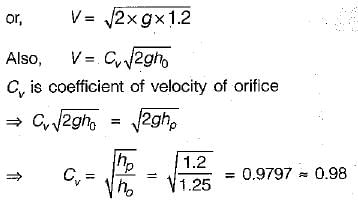Civil Engineering (CE) Exam > Civil Engineering (CE) Questions > An orifice is discharging under a head of 1.2...
Start Learning for Free
An orifice is discharging under a head of 1.25 m of water. A Pitot tube kept at its centre line at the vena contracta indicates a heap of 1.20 m of water. The coefficient of velocity of the orifice is
- a)0.99
- b)0.98
- c)0.965
- d)0.96
Correct answer is option 'B'. Can you explain this answer?
Verified Answer
An orifice is discharging under a head of 1.25 m of water. A Pitot tub...
h0 be the head of Orifice
hp be the head of Pitot tube
Velocity of emergence of water from orifice can be given by =

hp be the head of Pitot tube
Velocity of emergence of water from orifice can be given by =


Most Upvoted Answer
An orifice is discharging under a head of 1.25 m of water. A Pitot tub...
Given data:
Head at orifice = 1.25 m
Head at vena contracta = 1.20 m
Coefficient of velocity = ?
Calculation:
The velocity of flow at the vena contracta can be determined using Bernoulli’s equation as:
Head at orifice = Head at vena contracta + (Velocity head)
1.25 = 1.20 + (V^2/2g)
V^2/2g = 0.05
V = √(2g×0.05)
The discharge coefficient is given by the ratio of actual discharge through the orifice to the theoretical discharge, and is expressed as:
Cv = Actual discharge / Theoretical discharge
Theoretical discharge can be calculated using the formula:
Q = Cd x A x √(2gh)
where,
Cd = coefficient of discharge
A = area of the orifice
g = acceleration due to gravity
h = head of water above the center of the orifice
Since the area of the orifice is constant, we can write:
Theoretical discharge = Cd x A x √(2gh)
Actual discharge can be determined using the formula:
Actual discharge = Av x V
where,
Av = area of vena contracta
V = velocity of flow at vena contracta
Substituting the values, we get:
Actual discharge = Av x V
= π/4 x D^2 x √(2g×0.05)
Now, substituting the values of theoretical and actual discharge, we get:
Cv = Actual discharge / Theoretical discharge
= (π/4 x D^2 x √(2g×0.05)) / (Cd x A x √(2gh))
Simplifying the equation, we get:
Cv = 0.98
Therefore, the coefficient of velocity of the orifice is 0.98.
Answer: Option B (0.98)
Head at orifice = 1.25 m
Head at vena contracta = 1.20 m
Coefficient of velocity = ?
Calculation:
The velocity of flow at the vena contracta can be determined using Bernoulli’s equation as:
Head at orifice = Head at vena contracta + (Velocity head)
1.25 = 1.20 + (V^2/2g)
V^2/2g = 0.05
V = √(2g×0.05)
The discharge coefficient is given by the ratio of actual discharge through the orifice to the theoretical discharge, and is expressed as:
Cv = Actual discharge / Theoretical discharge
Theoretical discharge can be calculated using the formula:
Q = Cd x A x √(2gh)
where,
Cd = coefficient of discharge
A = area of the orifice
g = acceleration due to gravity
h = head of water above the center of the orifice
Since the area of the orifice is constant, we can write:
Theoretical discharge = Cd x A x √(2gh)
Actual discharge can be determined using the formula:
Actual discharge = Av x V
where,
Av = area of vena contracta
V = velocity of flow at vena contracta
Substituting the values, we get:
Actual discharge = Av x V
= π/4 x D^2 x √(2g×0.05)
Now, substituting the values of theoretical and actual discharge, we get:
Cv = Actual discharge / Theoretical discharge
= (π/4 x D^2 x √(2g×0.05)) / (Cd x A x √(2gh))
Simplifying the equation, we get:
Cv = 0.98
Therefore, the coefficient of velocity of the orifice is 0.98.
Answer: Option B (0.98)

|
Explore Courses for Civil Engineering (CE) exam
|

|
Question Description
An orifice is discharging under a head of 1.25 m of water. A Pitot tube kept at its centre line at the vena contracta indicates a heap of 1.20 m of water. The coefficient of velocity of the orifice isa)0.99b)0.98c)0.965d)0.96Correct answer is option 'B'. Can you explain this answer? for Civil Engineering (CE) 2025 is part of Civil Engineering (CE) preparation. The Question and answers have been prepared according to the Civil Engineering (CE) exam syllabus. Information about An orifice is discharging under a head of 1.25 m of water. A Pitot tube kept at its centre line at the vena contracta indicates a heap of 1.20 m of water. The coefficient of velocity of the orifice isa)0.99b)0.98c)0.965d)0.96Correct answer is option 'B'. Can you explain this answer? covers all topics & solutions for Civil Engineering (CE) 2025 Exam. Find important definitions, questions, meanings, examples, exercises and tests below for An orifice is discharging under a head of 1.25 m of water. A Pitot tube kept at its centre line at the vena contracta indicates a heap of 1.20 m of water. The coefficient of velocity of the orifice isa)0.99b)0.98c)0.965d)0.96Correct answer is option 'B'. Can you explain this answer?.
An orifice is discharging under a head of 1.25 m of water. A Pitot tube kept at its centre line at the vena contracta indicates a heap of 1.20 m of water. The coefficient of velocity of the orifice isa)0.99b)0.98c)0.965d)0.96Correct answer is option 'B'. Can you explain this answer? for Civil Engineering (CE) 2025 is part of Civil Engineering (CE) preparation. The Question and answers have been prepared according to the Civil Engineering (CE) exam syllabus. Information about An orifice is discharging under a head of 1.25 m of water. A Pitot tube kept at its centre line at the vena contracta indicates a heap of 1.20 m of water. The coefficient of velocity of the orifice isa)0.99b)0.98c)0.965d)0.96Correct answer is option 'B'. Can you explain this answer? covers all topics & solutions for Civil Engineering (CE) 2025 Exam. Find important definitions, questions, meanings, examples, exercises and tests below for An orifice is discharging under a head of 1.25 m of water. A Pitot tube kept at its centre line at the vena contracta indicates a heap of 1.20 m of water. The coefficient of velocity of the orifice isa)0.99b)0.98c)0.965d)0.96Correct answer is option 'B'. Can you explain this answer?.
Solutions for An orifice is discharging under a head of 1.25 m of water. A Pitot tube kept at its centre line at the vena contracta indicates a heap of 1.20 m of water. The coefficient of velocity of the orifice isa)0.99b)0.98c)0.965d)0.96Correct answer is option 'B'. Can you explain this answer? in English & in Hindi are available as part of our courses for Civil Engineering (CE).
Download more important topics, notes, lectures and mock test series for Civil Engineering (CE) Exam by signing up for free.
Here you can find the meaning of An orifice is discharging under a head of 1.25 m of water. A Pitot tube kept at its centre line at the vena contracta indicates a heap of 1.20 m of water. The coefficient of velocity of the orifice isa)0.99b)0.98c)0.965d)0.96Correct answer is option 'B'. Can you explain this answer? defined & explained in the simplest way possible. Besides giving the explanation of
An orifice is discharging under a head of 1.25 m of water. A Pitot tube kept at its centre line at the vena contracta indicates a heap of 1.20 m of water. The coefficient of velocity of the orifice isa)0.99b)0.98c)0.965d)0.96Correct answer is option 'B'. Can you explain this answer?, a detailed solution for An orifice is discharging under a head of 1.25 m of water. A Pitot tube kept at its centre line at the vena contracta indicates a heap of 1.20 m of water. The coefficient of velocity of the orifice isa)0.99b)0.98c)0.965d)0.96Correct answer is option 'B'. Can you explain this answer? has been provided alongside types of An orifice is discharging under a head of 1.25 m of water. A Pitot tube kept at its centre line at the vena contracta indicates a heap of 1.20 m of water. The coefficient of velocity of the orifice isa)0.99b)0.98c)0.965d)0.96Correct answer is option 'B'. Can you explain this answer? theory, EduRev gives you an
ample number of questions to practice An orifice is discharging under a head of 1.25 m of water. A Pitot tube kept at its centre line at the vena contracta indicates a heap of 1.20 m of water. The coefficient of velocity of the orifice isa)0.99b)0.98c)0.965d)0.96Correct answer is option 'B'. Can you explain this answer? tests, examples and also practice Civil Engineering (CE) tests.

|
Explore Courses for Civil Engineering (CE) exam
|

|
Signup for Free!
Signup to see your scores go up within 7 days! Learn & Practice with 1000+ FREE Notes, Videos & Tests.























